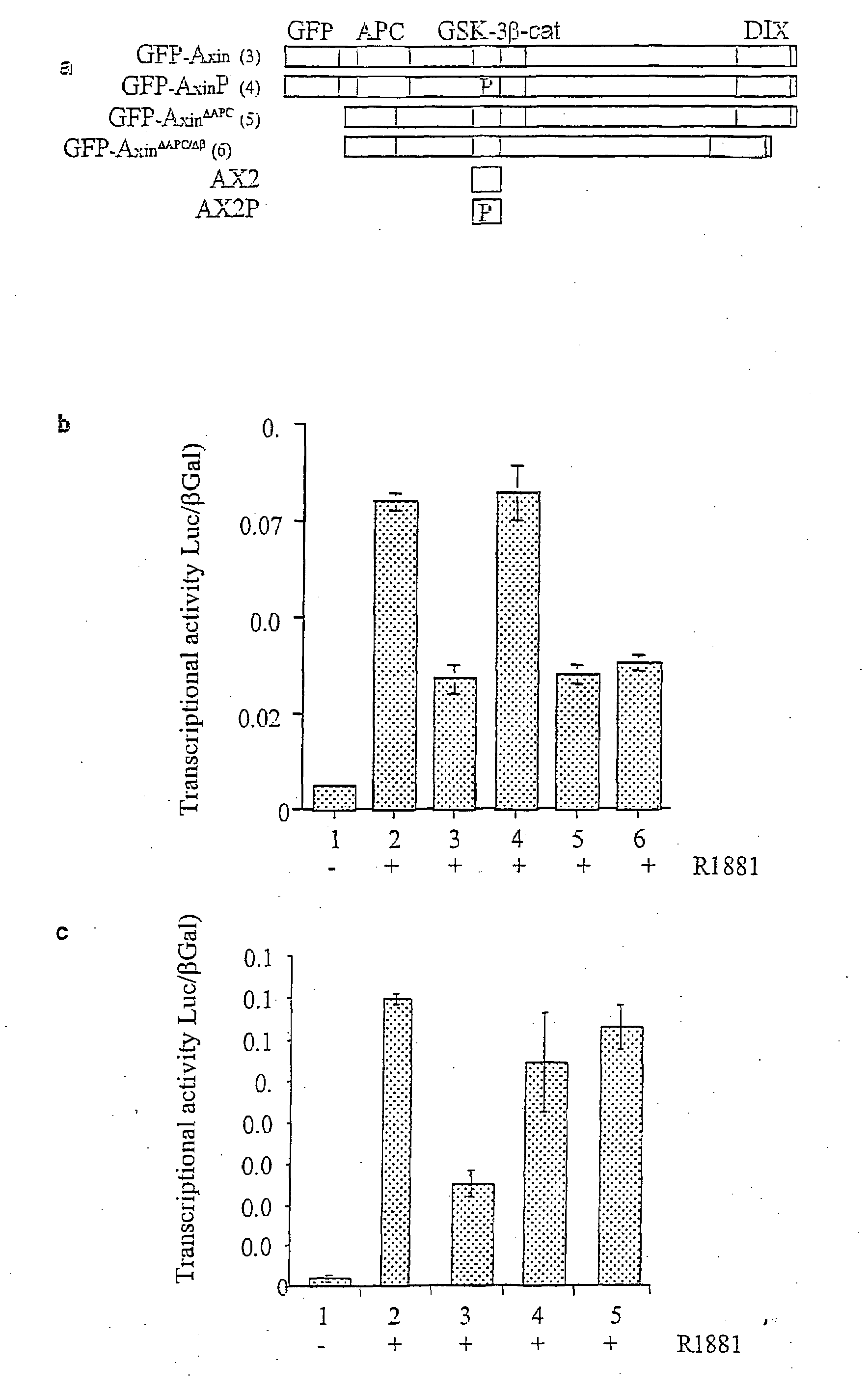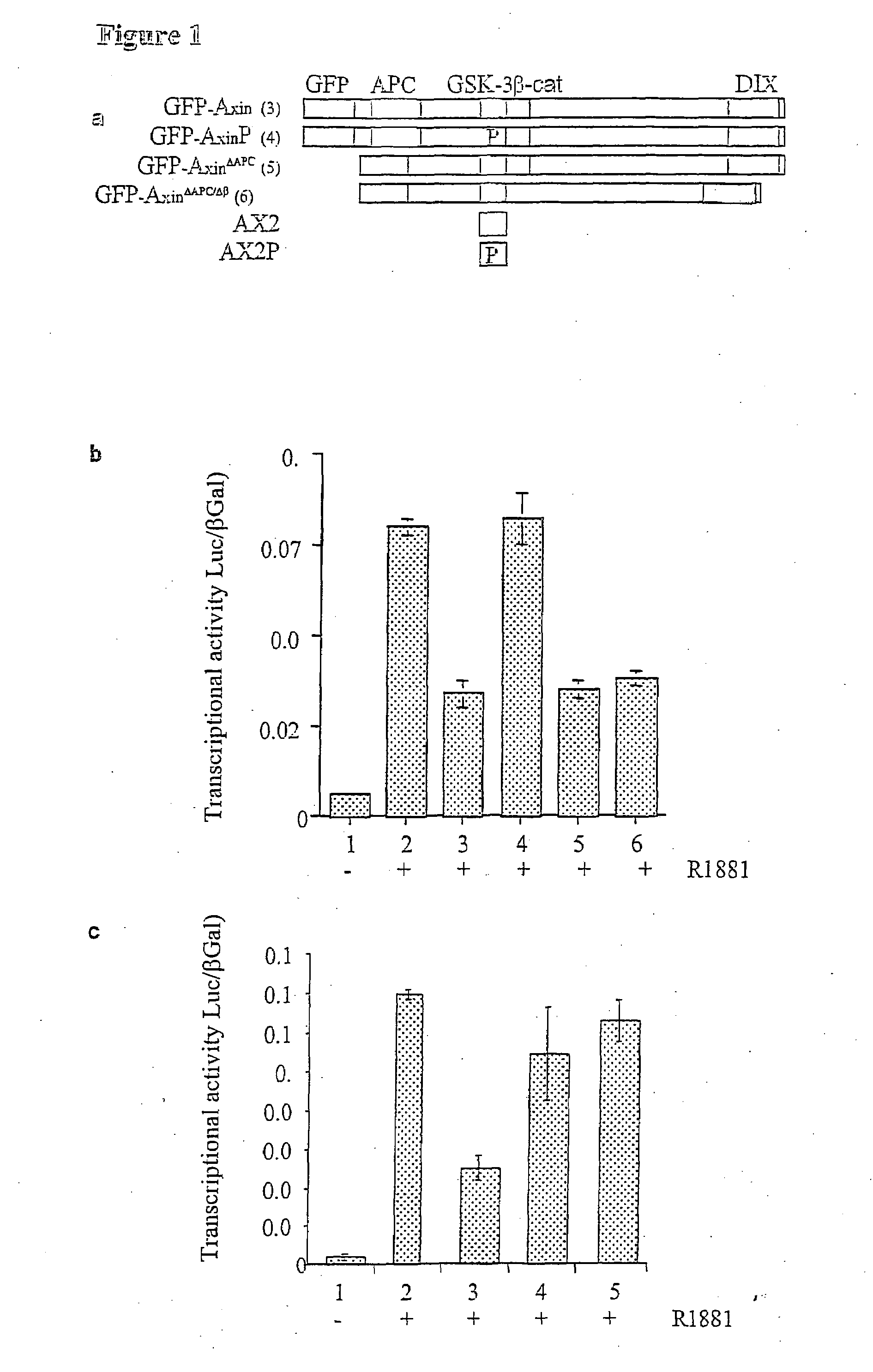Use of gsk-3 inhibitors for the treatment of prostate cancer
a technology of gsk3 inhibitors and prostate cancer, which is applied in the direction of enzyme inhibitors, biocides, enzyme inhibitor ingredients, etc., can solve the problems of high endogenous -catenin, high endogenous -catenin, and the inability to respond to androgen ablation. , to achieve the effect of reducing the toxicity of other cell types
- Summary
- Abstract
- Description
- Claims
- Application Information
AI Technical Summary
Benefits of technology
Problems solved by technology
Method used
Image
Examples
example 1
Inhibition of AR Transcriptional Activity by Axin
[0154]Axin inhibits the Wnt signaling pathway by acting as a scaffold protein, bringing together a number of proteins, including β-catenin, APC and GSK-3, and thereby promoting phosphorylation and degradation of β-catenin (for references see (Gregory et al, 2001; Kikuchi, 2000)). Ectopic expression of Axin is sufficient to inhibit Wnt / β-catenin signalling and is therefore often used as a tool to inhibit endogenous β-catenin function (Hsu et al., 2001; Reya et al, 2003; Ross et al, 2000). In order to determine whether endogenous β-catenin functions as a co-activator for the AR in prostate cancer cells, we expressed Axin in CWR-R1 cells. This is a cell line derived from the CWR22 xenograft model for prostate cancer that expresses endogenous AR (Gregory et al, 2001) and high levels of β-catenin (Chesire & Isaacs, 2002). For these studies we used a luciferase reporter plasmid driven by the MMTV promoter which contains androgen-receptor bi...
example 2
Depletion of Endogenous β-Catenin does not Inhibit Endogenous AR Transcriptional Activity in Prostate Cancer Cells
[0157]Our results using Axin suggest that endogenous β-catenin in prostate cancer cells does not affect AR activity. In order to test this possibility, we used a second approach to determine the effect of removing endogenous β-catenin on AR transcriptional activity. For these studies, we used a well-characterised β-catenin siRNA expression vector that has been shown to reduce β-catenin protein levels and inhibit β-catenin / Tcf transcriptional activity (van de Wetering et al, 2003). We first used HCT116 colon cancer cells, which have a stabilising mutation in β-catenin, and pOT-luciferase, a reporter plasmid with Tcf / LEF-1 binding sites. As expected, β-catenin siRNA inhibited β-catenin / Tcf-dependent transcription in HCT116 cells (FIG. 2a). β-catenin siRNA expression did not affect the activity of pOF-luciferase, which comprises the pOT promoter with mutations in the Tcf bi...
example 3
GSK-3 Increases AR Transcriptional Activity
[0159]Axin deletion analysis suggested an important role for GSK-3 in the regulation of AR activity. Therefore, we assessed the effects of overexpressing GSK-3 on AR transcriptional activity. For these studies we used wild-type GSK-3, a constitutively active form of GSK-3 that has a mutation at serine 9 (S9A), the inhibitory phosphorylation site, and a catalytically inactive form of GSK-3 (K216R). AR transcriptional activity was not significantly affected by expression of any of these constructs in 22Rv1 cells (FIG. 3a); GSK-3 S9A expression did result in a small increase in AR transcriptional activity in CWR-R1 cells (data not shown).
[0160]We reasoned that the weak effect of GSK-3 on AR activity might be because endogenous GSK-3 is already active in these cell lines. Therefore, we examined the effects of GSK-3 expression on AR transcriptional activity in LNCaP cells, in which GSK-3 is known to be inactive as a result of phosphorylation at ...
PUM
| Property | Measurement | Unit |
|---|---|---|
| Cell proliferation rate | aaaaa | aaaaa |
| Selectivity | aaaaa | aaaaa |
Abstract
Description
Claims
Application Information
 Login to View More
Login to View More - R&D
- Intellectual Property
- Life Sciences
- Materials
- Tech Scout
- Unparalleled Data Quality
- Higher Quality Content
- 60% Fewer Hallucinations
Browse by: Latest US Patents, China's latest patents, Technical Efficacy Thesaurus, Application Domain, Technology Topic, Popular Technical Reports.
© 2025 PatSnap. All rights reserved.Legal|Privacy policy|Modern Slavery Act Transparency Statement|Sitemap|About US| Contact US: help@patsnap.com



